15 Things We Love About ‘Band of Brothers’
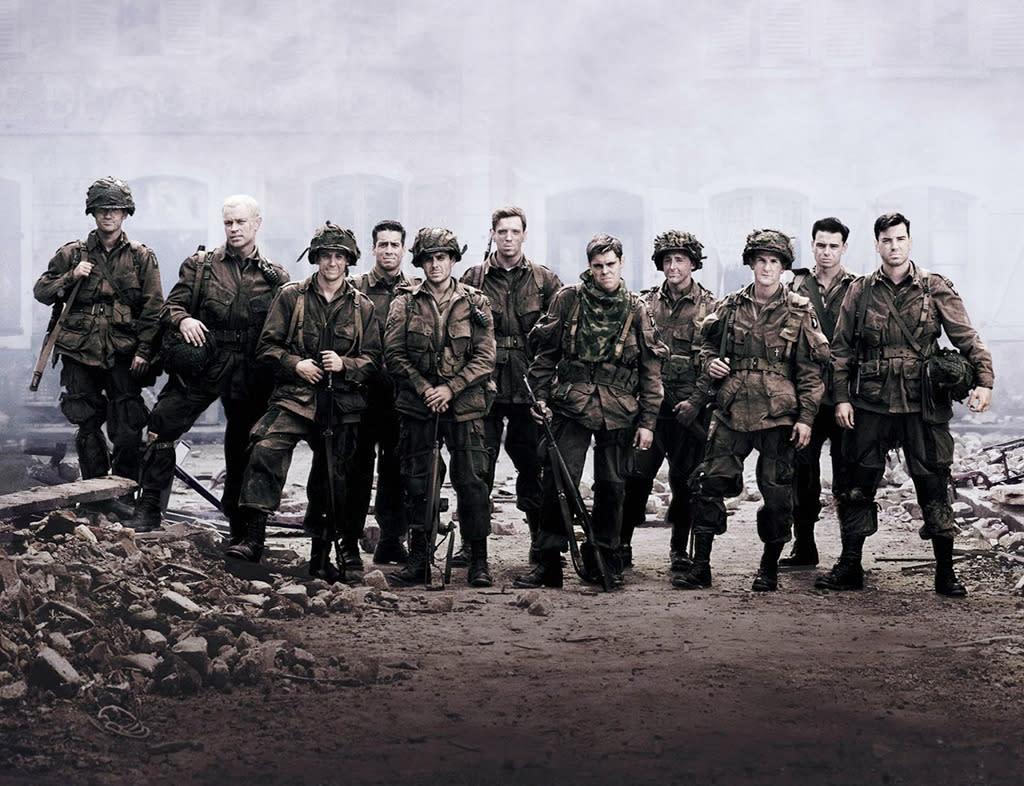
(HBO)
This September, Band of Brothers will celebrate its 15th anniversary. Can it really be 15 years since Steven Spielberg and Tom Hanks breathed new life into the TV landscape with their $125 million 10-episode WWII dramatic miniseries? Using historian Stephen E. Ambrose’s New York Times best-selling book of the same name as source material, Spielberg and Hanks assembled an unparalleled creative team (consisting of talented young actors and a sterling behind-the-scenes crew) to bring their vision to the small screen. Their subject? The heroes of “Easy” Company, part of the 506th Parachute Infantry Regiment of the 101st Airborne Division, who landed at Normandy and fought their way in less than a year to Hitler’s Berchtesgaden home in the Alps.
Memorial Day is a time to honor and remember the men and women who’ve died serving our country. Through its understated but eloquent celebration of the men of Easy Company, Band of Brothers pays particular homage to the ordinary citizens who, in all our wars, have been called upon to give extraordinary service to their country.
With that in mind as HBO Signature airs a complete marathon of the miniseries starting at 10 a.m. ET today, we look back at 15 things we love about Band of Brothers.
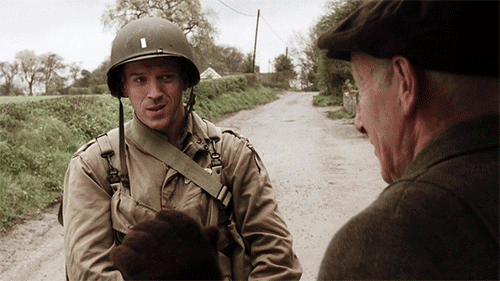
1. It’s still ranked as the No. 1 TV show on IMDB
That’s a pretty impressive feat for a miniseries that is about to turn 15 years old. What better evidence that Band of Brothers remains relevant and compelling a decade and a half after its debut? To be included on the IMDB Top Rated TV Shows list, a miniseries must have received ratings from at least 5,000 users. To give you an idea of the competition, Breaking Bad, Game of Thrones, and The Wire are currently in the #3, #4, and #5 spots on the list.

2. Everyone is in Band of Brothers… literally, everyone
No, we’re not exaggerating. While only Damian Lewis, Ron Livingston, Donnie Wahlberg, Scott Grimes (ER) and a few others appear in all 10 episodes, the men of Easy Company are comprised of some remarkably familiar faces including Kirk Acevedo, Eion Bailey, Michael Cudlitz, Jimmy Fallon (!), Colin Hanks, Neal McDonough, David Schwimmer, and Matthew Settle. Oh, but that’s just the Americans. The alert viewer can easily pick out such notable British actors as Jamie Bamber, Michael Fassbender, Dexter Fletcher, Stephen Graham, Tom Hardy, James McAvoy and Simon Pegg. All appeared in Band of Brothers before their “big breaks” elsewhere.
3. Interviews with the real men of 101st Airborne Division bookend almost each episode
While there are 500 speaking roles in Band of Brothers, perhaps the most powerful words are spoken by members of Easy Company themselves who appear at strategic intervals to recount their memories of the war. To maintain suspense about the fates of key members of the 101st, the creative team wisely waits to identify the speakers until the end of the 10th episode. However, the big reveal is hardly a surprise because the actors bear such an uncanny resemblance to their real-life counterparts that they essentially embody their roles.
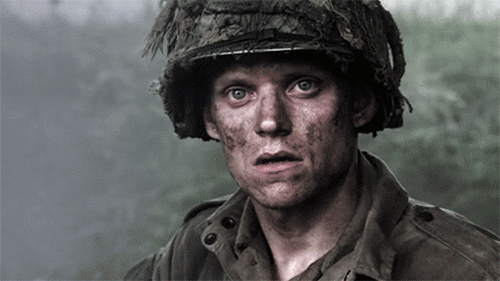
4. Each episode has a different protagonist within Easy Company
How do you tell a story that encompasses the experience of an entire Company? Miraculously, Spielberg and Hanks pulled it off by using seven different Easy Company men to serve as point-of-view characters for different stages of Easy Company’s trek through Europe. Damien Lewis’s Dick Winters (who works himself up to Major) is at the center of only three of the episodes, though he is a unifying presence in all 10. The other episodes are anchored by soldiers (and a medic) of all different ranks, giving the audience a feel for the collective experiences of the unit and keeping the series fresh.
5. “Currahee!”
The premiere episode of Band of Brothers arguably provides the greatest military training montage of all time, stretched over 90 minutes. David Schwimmer embraces the role of Captain Sobel, the maniacally demanding commander who appears to enjoy torturing the men of Easy Company (especially Dick Winters). The scenes of their multiple three-mile runs to the top of Currahee Mountain are among the most memorable in the series. Viewers fully appreciate why “Currahee!” later becomes a rallying cry for the unit. Ironically, it is thanks in large part to Sobel’s brutality that the men of Easy Company bond as a unit and are thoroughly prepared for the hardships of the battlefield.

(HBO/Getty Images)
6. The friendship between Dick Winters and Lewis Nixon
We really would like to think Damien Lewis and Ron Livingston hang out to this day, but we haven’t seen the paparazzi photos to prove it. As Dick Winters and Lewis Nixon, the two actors form a bond so believable you have to think they’ve been through real basic training together, not the Hollywood version. Our favorite moment is when a bullet ricochets off Nixon’s helmet as a horrified Winters looks on. The shock and relief in both men’s faces says it all.
7. D-Day (Brécourt Manor Assault)
While Spielberg showed us one version of the D-Day invasion in Saving Private Ryan, audiences were able to glimpse quite another in Band of Brothers. The men of Easy Company were paratroopers who leaped into the fiery skies over Normandy the night before the invasion. While the recreation of the harrowing parachute jump was incredible, the centerpiece of the second episode is the re-enactment of Easy Company’s attack of a fixed position held by a large force of Germans at Brécourt Manor. Dick Winters devised and led the assault so effectively that the tactics he employed are still taught at West Point. He also won himself the Silver Star.
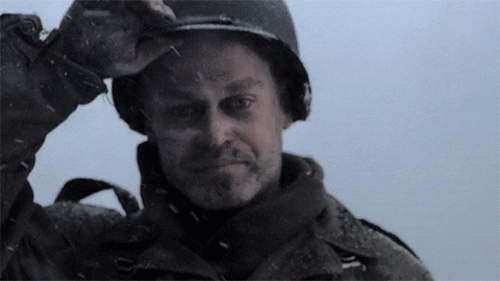
8. How it deals with PTSD
Of course, we now know it as Post-Traumatic Stress Disorder, but during World War II, the disorder, if diagnosed, was called “shell shock” and considered shameful. While a number of soldiers obviously suffer from some form of PTSD throughout the series, two examples stand out. One involves Private Albert Blithe (Marc Warren), who becomes increasingly disoriented after the jump at Normandy and finally suffers hysterical blindness during battle. He begins to function again only after Dick Winters is kind to him. McDonough’s Buck Compton, though, is the character who best displays the gradual onset of PTSD over many battles and humanizes the syndrome. The scene in which Buck finally reaches his breaking point (in the episode aptly titled, “The Breaking Point”) after witnessing the dismemberment of his two closest friends, is easily one of the most disturbing of the series.

9. Bastogne
Perhaps the most harrowing sequences in Band of Brothers take place in the forests of Bastogne in Belgium, the focal point of the Battle of the Bulge. The two episodes devoted to this struggle in the freezing, deadly woods not only show the careless brutality of actual combat, but also the agony associated with waiting for the enemy to strike. Inside their foxholes under the towering trees, the men have intervals when they reflect and bond, until the trees start exploding above them and fire rains down. This signature battle, during which Easy Company holds the line against German onslaughts at tremendous cost, is a turning point for the paratroopers — as well as the series. After Bastogne, they are certain only of each other.

(HBO)
10. The Blue Headscarf
Due to its focus around Easy Company, Band of Brothers does not feature many women or children. That makes the appearance of Nurse Renee (Lucie Jeanne) all the more striking. Medic Eugene Roe (portrayed masterfully by Shane Taylor) encounters her at a make-shift clinic in a Belgium church near Bastogne. The two bond by recounting mutual experiences, share a chocolate bar, and form a real connection. She seems untouchable — a beacon of light in the darkness — until the clinic is bombed. A stunned Eugene finds her blue headscarf among the rubble that had been the aid station. He absorbs the fact that no one is safe and continues to deal with a wounded soldier — which is what she would have expected.

11. The legend of Ronald C. Speirs
One of the true gems of the series is Matthew Settle’s complex performance as Ronald C. Speirs, a skilled Captain who understands that, for an officer, it is better to be feared than be loved. Settle expertly conveys the dual nature of Speirs. He is both the man who is believed to have killed a group of German POWs after offering them a smoke and the man who turns out to be the savior of Easy Company when their craven commander is paralyzed by his fear of battle. It’s a gripping performance, which makes you wonder: why isn’t Matthew Settle a bigger star?
12. The 9th episode, “Why We Fight”
For eight episodes, the men of Easy Company fight the Germans simply because they are the enemy. In this episode, they come to a much deeper understanding of why defeating Hitler is the right thing to do. When they finally enter Germany, they occupy a town called Landsberg where they stumble upon a concentration camp. The sequence that has them liberating starving prisoners while forcing Germans from the neighboring town to witness the horror is remarkably effective.
13. The occupation of Berchtesgaden
The men of Easy Company cap off their long journey by occupying Hitler’s famed holiday home, Berchtesgaden, better known as the Eagle’s Nest. In an incredible, eerie sequence, the men marvel at the castle-like interiors with stolen treasures from all of Europe on display. The surreal fortress is guarded by a dead Nazi officer who obviously committed suicide. Winters and Nixon smoke outside on the balcony, drink Hitler’s alcohol, uncover remarkable souvenirs (including Hitler’s photo albums), and admire the views of the Alps. It’s fitting that it is at this moment that they receive the news of the German army’s complete surrender.

14. “We salute the rank, not the man.”
Maybe the most satisfying line in the entire series. After working his way up to the rank of Major, Dick Winters encounters Schwimmer’s Captain Herbert Sobel, the man who tormented him and the men of Easy Company and even attempted to court-martial him. Now that he is out-ranked, Sobel averts his eyes to avoid Winters, but Winters can’t let him get away with it. It’s a glorious moment of comeuppance when Winters forces Sobel to acknowledge him.
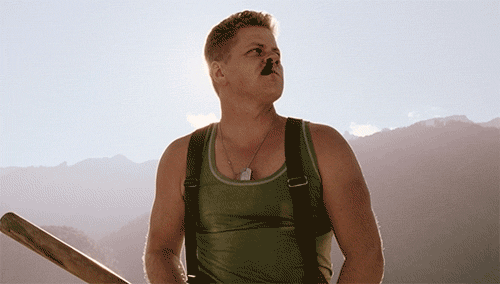
15. The ending baseball sequence
What better way to end the chronicles of Easy Company than with the survivors indulging in America’s favorite pastime? In this tasteful slow motion sequence, Damien Lewis’s Dick Winters narrates the fate of each featured member of this extraordinary unit. While Buck Compton went on to become the prosecutor who convicted Sirhan Sirhan, others found success in ordinary endeavors: they became construction workers, postmen, a cab driver, writers, and even handy men. It’s true when Winters says, “how we lived our lives after the war was as varied as each man.”
